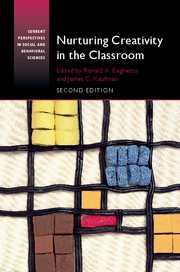Crossref Citations
This Book has been
cited by the following publications. This list is generated based on data provided by Crossref.
Amado, Diana
Sánchez-Miguel, Pedro Antonio
Molero, Pablo
and
Ito, Etsuro
2017.
Creativity associated with the application of a motivational intervention programme for the teaching of dance at school and its effect on the both genders.
PLOS ONE,
Vol. 12,
Issue. 3,
p.
e0174393.
Luria, Sarah R.
Sriraman, Bharath
and
Kaufman, James C.
2017.
Enhancing equity in the classroom by teaching for mathematical creativity.
ZDM,
Vol. 49,
Issue. 7,
p.
1033.
Sternberg, Robert J.
2019.
Why the tall-poppy syndrome is becoming worse in the creative professions / Razones por las que el síndrome de la amapola alta es cada vez más acentuado en las profesiones creativas.
Estudios de Psicología,
Vol. 40,
Issue. 3,
p.
497.
Kalin, Nadine M.
2019.
Decreating Entrepreneurialized Art Education.
Art Education,
Vol. 72,
Issue. 6,
p.
44.
Cotter, Katherine N.
Christensen, Alexander P.
and
Silvia, Paul J.
2019.
The Cambridge Handbook of Creativity.
p.
640.
Pugsley, Lina
and
Acar, Selcuk
2020.
Supporting Creativity Or Conformity? Influence of Home Environment and Parental Factors on the Value of Children's Creativity Characteristics.
The Journal of Creative Behavior,
Vol. 54,
Issue. 3,
p.
598.
McDonald, Jason K.
West, Richard E.
Rich, Peter J.
and
Hokanson, Brad
2020.
Handbook of Research in Educational Communications and Technology.
p.
375.
Corazza, Giovanni Emanuele
Reiter-Palmon, Roni
Beghetto, Ronald A.
and
Lubart, Todd
2021.
Intelligence and creativity in the space-time continuum for education, business, and development.
Journal of Creativity,
Vol. 31,
Issue. ,
p.
100003.
Abdulla Alabbasi, Ahmed M.
Hafsyan, Amnah S. M.
Runco, Mark A.
and
AlSaleh, Aseel
2021.
Problem Finding, Divergent Thinking, and Evaluative Thinking Among Gifted and Nongifted Students.
Journal for the Education of the Gifted,
Vol. 44,
Issue. 4,
p.
398.
Sternberg, Robert J.
and
Chowkase, Aakash
2021.
When We Teach for Positive Creativity, What Exactly Do We Teach For?.
Education Sciences,
Vol. 11,
Issue. 5,
p.
237.
Corazza, Giovanni Emanuele
Darbellay, Frédéric
Lubart, Todd
and
Panciroli, Chiara
2021.
Creativity and Learning.
p.
69.
Piirto, Jane
2021.
Organic Creativity for 21st Century Skills.
Education Sciences,
Vol. 11,
Issue. 11,
p.
680.
Magalhães, Andreia
Andrade, António
and
Alves, José Matias
2021.
Information Technology and Systems.
Vol. 1331,
Issue. ,
p.
110.
Walan, Susanne
2021.
The dream performance – a case study of young girls’ development of interest in STEM and 21st century skills, when activities in a makerspace were combined with drama.
Research in Science & Technological Education,
Vol. 39,
Issue. 1,
p.
23.
Neville, Ross D
and
Makopoulou, Kyriaki
2021.
Effect of a six-week dance-based physical education intervention on primary school children’s creativity: A pilot study.
European Physical Education Review,
Vol. 27,
Issue. 1,
p.
203.
Magalhães, Andreia
Alves, José Matias
and
Andrade, António
2021.
Trends and Applications in Information Systems and Technologies.
Vol. 1367,
Issue. ,
p.
22.
Patston, Timothy J.
Kaufman, James C.
Cropley, Arthur J.
and
Marrone, Rebecca
2021.
What Is Creativity in Education? A Qualitative Study of International Curricula.
Journal of Advanced Academics,
Vol. 32,
Issue. 2,
p.
207.
Kapoor, Hansika
Reiter-Palmon, Roni
and
Kaufman, James C.
2021.
Norming the Muses: Establishing the Psychometric Properties of the Kaufman Domains of Creativity Scale.
Journal of Psychoeducational Assessment,
Vol. 39,
Issue. 6,
p.
680.
Ceh, Simon Majed
and
Lebuda, Izabela
2022.
A Black Mirror of Bright Ideas: Could Media Educate towards Positive Creativity?.
Education Sciences,
Vol. 12,
Issue. 6,
p.
402.
Beghetto, Ronald A.
and
Anderson, Ross C.
2022.
Positive Creativity Is Principled Creativity.
Education Sciences,
Vol. 12,
Issue. 3,
p.
184.



